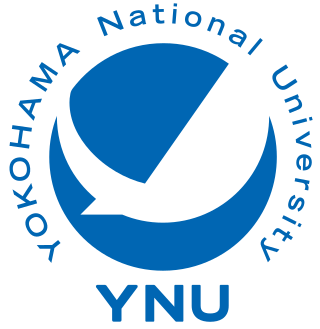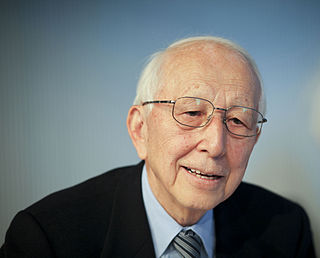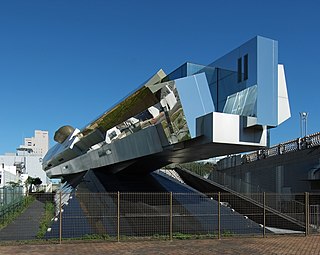
Reona Esaki, also known as Leo Esaki, is a Japanese physicist who shared the Nobel Prize in Physics in 1973 with Ivar Giaever and Brian David Josephson for his work in electron tunneling in semiconductor materials which finally led to his invention of the Esaki diode, which exploited that phenomenon. This research was done when he was with Tokyo Tsushin Kogyo. He has also contributed in being a pioneer of the semiconductor superlattices.

Yokohama National University, abbreviated to Yokokoku (横国) or YNU, is a national university located in Yokohama, Kanagawa Prefecture, Japan. Founded in 1876, it became a national university in 1949, and currently comprises five graduate schools and four undergraduate faculties.
Riken is a large scientific research institute in Japan. Founded in 1917, it now has about 3,000 scientists on seven campuses across Japan, including the main site at Wakō, Saitama Prefecture, just outside Tokyo. Riken is a Designated National Research and Development Institute, and was formerly an Independent Administrative Institution.

Fumihiko Maki is a Japanese architect who teaches at Keio University SFC. In 1993, he received the Pritzker Prize for his work, which often explores pioneering uses of new materials and fuses the cultures of east and west.

Tokyo University of Science, formerly "Science University of Tokyo" or TUS, informally Rikadai (理科大) or simply Ridai (理大) is a private research university located in Shinjuku, Tokyo, Japan.
Shigeo Hirose is a pioneer of robotics technology and a professor at the Tokyo Institute of Technology.

Makoto Kobayashi is a Japanese physicist known for his work on CP-violation who was awarded one-fourth of the 2008 Nobel Prize in Physics "for the discovery of the origin of the broken symmetry which predicts the existence of at least three families of quarks in nature."

Yokohama City University (YCU) is a public university, in Yokohama, Kanagawa Prefecture, Japan. As of 2013, YCU has two faculties with a total of around 4,850 students, 111 of whom are foreign. YCU also has four campuses and two hospitals. YCU is a member of the Port-City University League (PUL), and a core member of the Japanese University Network in the Bay Area (JUNBA). In 2017, YCU has been ranked #16th among "world's best small universities" in 2016-2017, ranked at 23rd among life sciences institutes in Japan.

Akira Fujishima (藤嶋 昭, Fujishima Akira, born March 10, 1942) is a Japanese chemist and president of Tokyo University of Science. He is known for significant contributions to the discovery and research of photocatalytic and superhydrophilic properties of titanium dioxide (TiO2), which is also known as the Honda-Fujishima effect.

Makoto Sei Watanabe is a Japanese architect living in Tokyo. He designed such buildings as Japan's K Museum, has lectured at universities around Japan, and won many awards for his designs. He is the author of The Induction Cities, published in 2002.
Brian Keith Hall is the George S. Campbell Professor of Biology and University Research Professor Emeritus at Dalhousie University in Halifax, Nova Scotia. Hall has researched and extensively written on bone and cartilage formation in developing vertebrate embryos. He is an active participant in the evolutionary developmental biology (EVO-DEVO) debate on the nature and mechanisms of animal body plan formation. Hall has proposed that the neural crest tissue of vertebrates may be viewed as a fourth embryonic germ layer. As such, the neural crest - in Hall's view - plays a role equivalent to that of the endoderm, mesoderm, and ectoderm of bilaterian development and is a definitive feature of vertebrates. As such, vertebrates are the only quadroblastic, rather than triploblastic bilaterian animals. In vertebrates the neural crest serves to integrate the somatic division and visceral division together via a wide range novel vertebrate tissues.
Kyoko Nozaki is a Japanese chemist and Professor of Chemistry at University of Tokyo in Japan.
Setsuro Ebashi MJA ForMemRS was a prominent Japanese physiologist who uncovered the regulatory role of calcium in cells. He is famous for the discovery of Troponin in 1965, which is integral to muscle contraction, as well as for the contribution of diagnosis of muscular dystrophy.
The Kihara Memorial Foundation Academic Award is an award for biological sciences in Japan. It is awarded annually by the Kihara Memorial Yokohama Foundation for the Achievement of Life Sciences, to commemorate Hitoshi Kihara, Japan's pioneer geneticist.

Claudio Daniel Stern FRSB, FMedSci, FRS is a Uruguayan biologist currently working at University College London (UCL).
Development Growth & Differentiation is a peer-reviewed scientific journal published by Wiley on behalf of the Japanese Society of Developmental Biologists. It was established in 1950 as Embryologia, obtaining its current title in 1969. The editor-in-chief is Masanori Taira. According to the Journal Citation Reports, the journal has a 2020 impact factor of 2.053.
Kenzō Yagi was a Japanese mineralogist and petrologist who specialized in experimental mineralogy and petrology. Yagiite, a new mineral found in the Colomera meteorite, was named after him for its contribution to the petrology.
Makoto Yano is a Japanese economist, currently the President and Chief Research Officer of the Research Institute of Economy, Trade and Industry. He is also a Professor Emeritus at Kyoto University and a Professor by Special Appointment at Kyoto University's Institute of Economic Research and Sophia University.
David Lorn Garbers was an American scientist who primarily researched reproductive biology, particularly the communication between egg and sperm cells. In 1993, he was elected to the National Academy of Sciences.

Naohide Yatsu was a Japanese biologist, geneticist, and embryologist. Yatsu received his Ph.D. from Columbia University and was a pioneer in embryonic induction and laid the foundations for zoology research in Japan.










